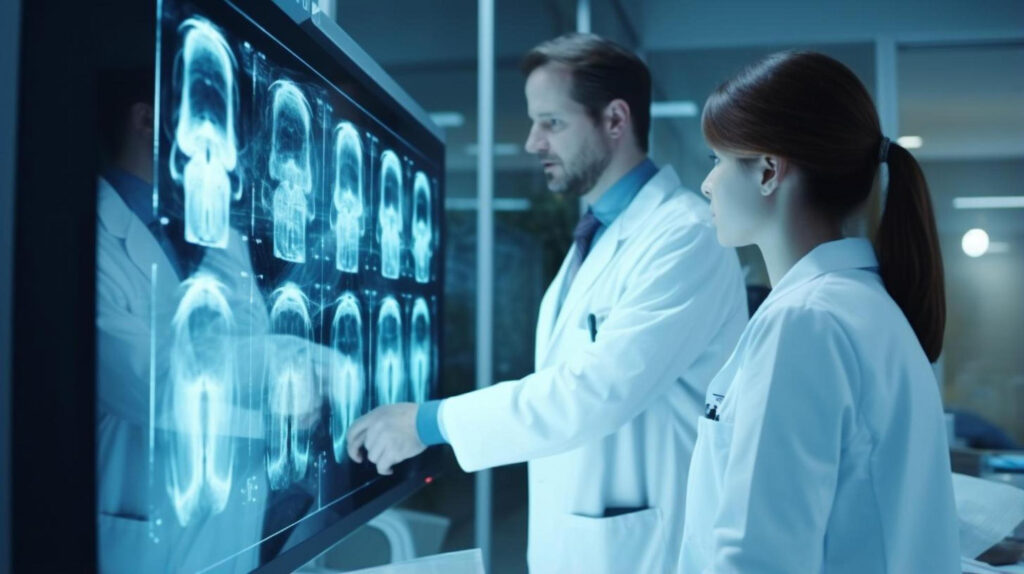In the current digital healthcare environment, medical imaging data management must be done effectively. This is where PACS and RIS administrators come into play; they are essential to a radiology department to function smoothly.
What is RIS?
A software program called the Radiology Information System (RIS) simplifies the administrative tasks performed in radiology departments. It serves as the main hub for overseeing the following:
- Patient scheduling: Appointments for MRIs, CT scans, X-rays and other imaging procedures can be made using RIS.
- Order processing: Using RIS, physicians can electronically request imaging tests for their patients.
- Workflow management: From scheduling to reporting, RIS keeps track of every imaging exam.
- Reporting: Reports entered into the RIS by radiologists can be dictated and the referring physicians receive them automatically.
In essence, RIS ensures a seamless flow of information throughout the entire radiology process.
Responsibilities of a PACS/RIS Administrator
A PACS/RIS Administrator is responsible for the day-to-day operation and maintenance of both the Picture Archiving and Communication System (PACS) and the Radiology Information System (RIS). Their core responsibilities include:
- System management and maintenance: This includes assuring the seamless running of PACS and RIS, as well as performing system backups and applying updates and upgrades.
- User Management and Training: PACS/RIS administrators set up and maintain user accounts and they train employees on how to use these systems successfully.
- Data security and archiving: They are critical for preserving patient data and ensuring compliance with healthcare legislation such as HIPAA. This includes handling data archiving and storage practices.
- Interface Management: Many hospitals have integrated PACS and RIS with other hospital information systems. The PACS/RIS administrator looks after these interfaces and troubleshoots any integration issues.
Managing PACS and RIS Systems
A radiology department that runs smoothly requires effective administration of its PACS and RIS systems. When it comes to system management, PACS/RIS administrators wear several hats. They are responsible for two important areas:
System configuration and optimization
- Configuration: It entails the modification of PACS and RIS to fit the specific demands of the radiology department. This includes setting up procedures, user interfaces and security settings.
- Optimization: PACS/RIS administrators regularly analyze system performance and discover opportunities for improvement. They may improve storage allocation, change network settings, as well as use data compression techniques to ensure quick access to medical images and smooth system performance.
Here’s how system configuration and optimization can help your organization:
- Improved Efficiency: Efficient systems enable technologists and radiologists to swiftly access and interpret pictures, resulting in faster diagnosis and treatments.
- Enhanced Image Quality: Appropriate settings ensures that photographs are stored and shown at their greatest quality.
- Reduced Costs: Efficient system optimization and data storage can help reduce storage expenses.
User Management and Access Control
- User Accounts: PACS/RIS administrators manage and set up user accounts for employees of radiology department and other authorized personnel. This includes providing necessary access levels and creating user roles to protect data.
- Access Control: They create and implement access control measures to make sure that only those with permission can edit and view patient information. This includes monitoring user activities and implementing user authentication methods.
Data Management and Integration
In the field of medical imaging, effective data management and smooth system integration are essential. PACS/RIS administrators play a critical role in ensuring both.
DICOM and HL7 standards
DICOM (Digital Imaging and Communications in Medicine) is the standard in the industry for storing, transmitting and managing medical images. PACS/RIS administrators guarantee their systems are DICOM-compliant, ensuring compatibility with various imaging equipment and software applications.
HL7 (Health Level Seven) comprises a set of standards for electronically exchanging healthcare information. PACS/RIS administrators uphold integrations between PACS, RIS and other hospital information systems using HL7 protocols. This facilitates a seamless flow of patient data across different departments, thereby enhancing overall healthcare delivery.
Integration with other hospital systems
- Electronic Health Records (EHR) Integration: A cohesive PACS and RIS system enables radiologists to access a patient’s complete medical history, encompassing prior imaging studies and lab findings, directly within the EHR platform. This fosters a more thorough approach to patient diagnosis and treatment.
- Laboratory Information System (LIS) Integration: Connecting with the LIS allows for the seamless transfer of patient data and results between radiology and the laboratory unit, enhancing efficiency in workflows and communication.
Effective integration with other hospital systems fosters collaboration between departments and ultimately enhances the quality of patient care.
Quality Assurance and Compliance
Ensuring regulatory compliance and maintaining high quality standards are pivotal responsibilities in PACS and RIS administration. Here’s how PACS/RIS administrators contribute:
Ensuring system reliability and performance
- System Monitoring: System monitoring involves the continuous tracking of system performance metrics such as uptime, response times and storage capacity. This proactive approach assists in detecting potential issues early and preventing system outages that might disrupt radiology operations.
- Disaster Recovery Planning: PACS/RIS administrators play a significant role in the development and execution of disaster recovery plans. This encompasses establishing backup procedures and decreasing data redundancy to reduce downtime in the event of system failures or emergencies.
Reliable and high-performing systems are crucial for ensuring uninterrupted radiology services and prompt access to patient data.
Compliance with regulations such as HIPAA
HIPAA Compliance: The Health Insurance Portability and Accountability Act (HIPAA) sets national standards for safeguarding sensitive patient health information. PACS/RIS administrators are tasked with enforcing and upholding security measures that align with HIPAA’s regulations. This includes managing user access controls, data encryption and audit logging.
Complying with HIPAA guidelines is not only a legal requirement, but also builds patient trust in your organization’s commitment to data security.
Workflow Analysis and Optimization
Streamlining workflows within the radiology department is critical for increasing efficiency and providing better patient care. PACS/RIS administrators play a pivotal role in this endeavor through:
Identifying bottlenecks and inefficiencies
- Process Analysis: They conduct regular process analyses to identify bottlenecks that may be creating delays in scheduling, picture acquisition, reporting and other areas. This could include reviewing user activity logs, detecting repeated processes and soliciting feedback from employees.
- Problem-solving: Once bottlenecks are discovered, PACS/RIS administrators collaborate with radiologists, techs and other radiology personnel to find solutions. This could include changes to the system configuration, workflow adjustments or even the exploration of new PACS and RIS functionality.
By proactively detecting and fixing bottlenecks, PACS/RIS administrators can greatly enhance patient throughput in the radiology department.
Implementing process improvements
- Automation: RIS/PACS administrators can use automation technologies to streamline repetitive processes. This may include automating report generation, forwarding images for inspection or sending appointment reminders.
- Customization: They can tailor workflows within RIS AND PACS to meet the department’s specific needs. This could include modifying user interfaces or designing custom report templates.
Implementing these process changes can result in faster response times, increased productivity and higher patient satisfaction.
User Training and Support
Equipping employees with the knowledge and skills they need to use PACS and RIS successfully is critical for optimal system adoption and workflow efficiency. PACS/RIS administrators play an important role in providing continual user training and support.
Providing training sessions for staff
- New User Training: When new radiology staff members start, PACS/RIS administrators provide extensive training on how to navigate the systems and use their features. This could include classroom sessions, hands-on training activities, access to user guides and internet resources.
- Ongoing Training: Healthcare technology is continually evolving. PACS/RIS administrators hold regular training sessions to keep employees informed about new features and functions in the systems. This ensures that staff are utilizing the full potential of PACS and RIS for best patient care.
Offering ongoing technical support
- Troubleshooting: When employees experience technical difficulties with PACS or RIS, PACS/RIS administrators give prompt troubleshooting and support. This could include resolving user access issues, troubleshooting system downtime or escalating complex issues to vendors for further support.
- User Feedback: They actively solicit input from employees about their experiences using PACS and RIS. This input might help to discover areas for improvement in systems or training programs.
PACS/RIS administrators empower personnel to use the systems efficiently by offering extensive training and continuing support, resulting in a smooth-running radiology department.
System Upgrades and Expansion
As technology advances and the volume of imaging data increases, it is critical to have a strong and scalable PACS and RIS infrastructure. PACS/RIS administrators play an important role in ensuring the systems can fulfill current and future needs by:
Planning and executing system upgrades
- Technology Assessment: Staying informed on the latest advancements in PACS and RIS technology involves actively engaging in industry conferences, conducting research on new features and evaluating potential benefits for the radiology department.
- Upgrade Implementation: When a system upgrade is necessary, PACS/RIS administrators actively participate in the planning and execution process. This includes close collaboration with IT staff, vendors and department heads to ensure a seamless transition with minimal disruption to workflow.
Regular system upgrades are essential to access the latest functionalities, enhance performance and bolster security features.
Scaling the system to meet growing needs
Storage Management: Medical imaging data can pile up quickly. PACS/RIS administrators create storage management methods, such as using data compression techniques or exploring cloud-based storage options.
System Capacity Planning: They proactively monitor system capacity and forecast future requirements based on factors such as patient numbers and the introduction of new imaging modalities. This allows for timely update or storage expansion and processing capabilities.
By proactively preparing for system upgrades and scalability, PACS/RIS administrators ensure that the radiology department is prepared to meet the ever-increasing demands of medical imaging.
Crisis Management and Disaster Recovery
In the unfortunate case of a system failure or emergency, a well-defined response strategy is critical to reducing downtime and ensuring patient care continuity. PACS/RIS administrators play an important role in:
Developing contingency plans
- Risk Assessment: They work with IT and radiology department heads to identify potential vulnerabilities to PACS and RIS operations. This could include hardware malfunctions, power outages, cyberattacks or natural disasters.
- Disaster Recovery Plan: Based on the risk assessment, PACS/RIS administrators help to create a complete disaster recovery strategy. This strategy should include data backup and restoration procedures, alternative methods of obtaining patient information, as well as emergency communication protocols for staff and patients.
A well-defined disaster recovery strategy enables a rapid and coordinated reaction to lessen the impact of unforeseen catastrophes while keeping patient care a primary priority.
Responding to system failures and emergencies
Incident Response: When a system failure or emergency happens, PACS/RIS administrators act quickly to implement the disaster recovery strategy. This could include initiating backups, switching to different workflows or contacting vendors for technical support.
Communication and Documentation: Throughout the crisis, they keep open lines of communication with employees, IT people and radiology department leadership. This includes documenting all activities done and informing everyone about the condition and expected recovery timeframe.
Effective reaction to system breakdowns and emergencies reduces downtime, preserves patient data and helps restore normal radiology operations as soon as possible.
Conclusion
In conclusion, PACS/RIS administrators play a crucial behind-the-scenes role in maintaining a well-functioning radiology department. Their proficiency in managing systems, safeguarding data, streamlining workflows and supporting users significantly contributes to the effective delivery of patient care. By employing a skilled PACS/RIS administrator, your healthcare institution can ensure the optimal use of PACS and RIS, streamline workflows, enhance data security and ultimately provide exceptional patient care.
Staffing Made Effortless. Let the Experts Handle Your Hiring
Helping companies discover the perfect talent for their needs. Finding the right individuals to drive your success is what we excel at.





